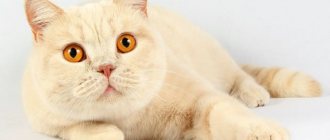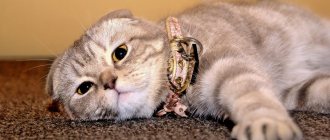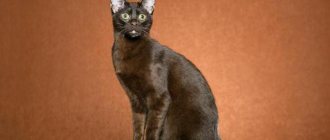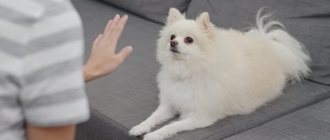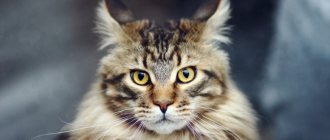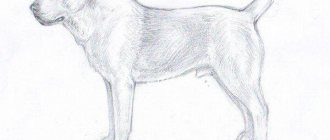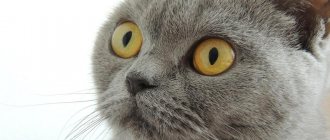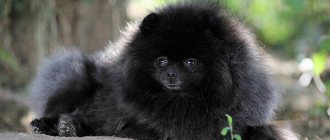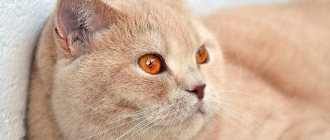To breed the fiery coat color of British cats, breeders used Persian genes. Getting a uniform color proved to be a challenge. Test work continues.
Ginger British cats gained worldwide popularity at the end of the 19th century thanks to the unusual color of their fur coat, plush to the touch, and the surprised look of their large eyes. British cats have a large, muscular body, not inferior in grace to any other breed.
Features of color
At exhibitions, strict requirements are put forward for pets. A Briton with a uniform, rich red color is allowed to participate. The hair is uniform throughout its length. The standard allows partial tabby coloring on the forehead in the form of the letter “M”, paws, and tail; inclusions in the form of white wool are rejected. The paw pads and nose are a brick-red, terracotta shade a tone darker than the cat's fur. Eye color is red and yellow.
British shorthair
The British Shorthair cat is characterized by a plush coat, round eyes and small ears. The coat is harsh, dense with a thick, uniformly colored undercoat. Soft is a disadvantage.
The right approach to feeding
Having given preference to natural nutrition, it is necessary to include raw lean meat in the animal’s diet.
An important aspect of keeping British cats at home is a healthy diet. Tawny British kittens up to six months of age should receive food at least 5 times a day. Older pets are fed twice a day: morning and evening. Description of the basic rules of proper nutrition for the British:
- fresh food;
- food at room temperature;
- feeding at the same time;
- removing leftover food from the bowl;
- the presence of a cup of clean water next to the food plate.
As for the products for feeding the British, it is allowed to feed the pet with store-bought food, but many owners prefer to pamper their cats with natural food. An unbalanced diet can harm the animal. The menu of British cats includes lean raw meat. The product is pre-frozen for 2 days to get rid of pathogenic microorganisms. Preference is given to beef, which is cut into small cubes along with films and veins. It is permissible to give such meat daily. This food improves chewing reflexes and protects teeth from the formation of tartar deposits.
It is allowed to include turkey, chicken, and rabbit in food. The British also love offal, especially liver. Boiled fish and fermented milk products are allowed in limited quantities. This food will provide the body with the required nutrients and vitamins. It is useful to add porridge, eggs and fresh vegetables to the menu.
lop-eared british
Representatives of the Scottish breed have kittens with straight ears. The fold-eared cat becomes later. They are often confused with the British. The breeds are really similar. However, red-haired Britons have small, wide-set, straight ears. The red fold-eared British cat is a myth.
red british cat photo
Description of the appearance of the fluffy handsome man
A ginger British cat should have a solid red color. The coat should be free of marks, patterns and white hairs. The villi should be the same color from root to tip. Solid color is rare, often in males. The coat of red British kittens can be short or long. Soft and dense to the touch, it resembles plush toys. The body of cats is strong and muscular, with a wide chest. The limbs are short, the color of the pads and nose can be from brick to bright red, but pink can also be found.
As for the head, it is large, round, with thick cheeks. The British cat has small ears with rounded ends. Her eyes are large, round and wide-set. Their color is gold and orange with a characteristic brick-colored eyeliner. The tail of these pets is short, but thick, with a rounded tip. British sizes range from medium to large. Weight can reach 10 kg. Life expectancy is about 15 years, depending on living conditions and care.
Sometimes kittens of the Scottish and British breeds are confused, since both are born with erect ears. However, the British Fold cat of red color does not exist in nature.
How to get color
The genetic feature of the fiery color is the impossibility of obtaining a cat of a single color. The tabby pattern is always present, although not pronounced.
Red (cream) color is usually denoted by the letter “O”, meaning red (orange). The "O" mutation is found on the female "X" chromosome. Such a gene is called sex-dependent.
The brightness of the color depends on the “D” gene: with the dominant gene (D), the pigment lies evenly, the kittens are bright red; with recessive (gene d) - vice versa: cream.
It is possible to determine whether a carrier has the gene for the required color using genetic tests.
Red color gene
Like humans, females have two X chromosomes (XX), while males have one (XY). It turns out that a fiery-colored cat is much less common.
Genetic color formula:
- OO DD/Oo DD – cat/cat of bright red color;
- OO Dd/Oo Dd – a cat/cat of a bright red color, but they are carriers of a cream color;
- OO dd/Oo dd – cream-colored cat/cat.
Example:
- The pair OO DD + Oo DD will give birth to bright red kittens.
- In the pair OO Dd + Oo Dd, no more than a quarter of the offspring will have a cream color.
- The pair OO dd + Oo dd will give birth to kittens with only cream coat color.
The probability that ginger cats with Oo dd and Oo dd formulas will give birth to kittens with a color different from their parents is 25%.
kittens
Little British Reds come in both short-haired and long-haired varieties. The richer the color of a kitten’s coat, the higher its value. Sometimes white hairs are observed on the body. If they do not disappear with age, then there should be no talk of any exhibitions. Usually kittens are born with tabby markings, but with age the pattern becomes almost invisible, and it is called monochromatic.
To maintain bright color and shine, cats' fur is washed twice a month. To avoid damage to the skin and undercoat of a ginger cat, combing with tools with hard metal teeth is not recommended. Soft, silky wool is a minus. According to standards, babies should have a thick, moderately hard undercoat.
The color of the nose is red. Particular importance is paid to eye color. An iris of orange, copper, and gold colors is welcome. Green is not allowed for exhibitions.
Disadvantages of British redheads
The main disadvantage is that the standard color is extremely rare. Only a few can boast of a rich coat color, as well as a monochromatic one. Usually there is either an uneven color or there are white spots on the body. No one will allow such animals into exhibitions, although they are incredibly beautiful. Red tabby kittens and ticked kittens are not allowed.
The peculiarities of red are that the color fully corresponds to the declared one and there is not a single deviation of even a half tone. Only in this case can saffron milk caps be purebred. Today, meeting such people is a great success, and buying one is real happiness.
Did you like the article?
Who would suit a red-haired Briton?
Many people think that color does not affect character. Breeders have a different opinion: British redheads are considered to be real aristocrats. They do not bother their owner by meowing. They don’t get in their way when begging for anything. They are reserved and independent. They lead a sedentary, quiet lifestyle.
Smart by nature. They become toilet trained instantly, all you have to do is show the kitten the litter box once. British cats are clean and do not require careful, long-term care. Cats have good health.
British ginger cats are attached to their owners, but are not known for their affection: they rarely allow themselves to be stroked and do not sit on laps. They get along with both children and animals: a dog will become a good friend for a Briton. They play with children according to their mood, often ignoring them. When a person pays increased attention to his person, he will not release his claws and will prefer to leave. They love solitude, and therefore are suitable for busy and business people.
Video “Ginger cat of Scottish breed”
A video about a funny Scottish cat who can sit on its tail and play funny will give you a moment of positivity.
Was this article helpful?
Thank you for your opinion!
The article was useful. Please share the information with your friends.
Yes (100.00%)
No
X
Please write what is wrong and leave recommendations on the article
Cancel reply
Rate the benefit of the article: Rate the author ( 3 votes, average: 5.00 out of 5)
Discuss the article:
Advantages and disadvantages
The advantages include the British cat's calm character, cleanliness, and ability to get along with any family member, including other pets.
Good mental abilities are also a plus: cats understand prohibitions the first time.
About the disadvantages: red color in British cats is very rare. Often there is an uneven color with white spots on the tail, paws, and chest. Such cats are beautiful, but they will not be allowed into the exhibition.
The disadvantages include heavy shedding at least 2 times a year. During this period, special attention should be paid to hair care. It is recommended to comb out at least once a week, and with the onset of winter, this procedure is carried out daily.
The sedate lifestyle of a British breed cat is fraught with obesity. It is necessary to monitor portion sizes, play with your pet, and walk it.
Subtleties of content: how to deal with the red-haired beast?
In order for the furniture to remain intact, it is recommended to equip the cat with her resting place, and install a scratching post there.
Having decided to get a British kitten, it is important to prepare. You need to decide on a place for your pet to sleep and rest, purchase a cat house or bed. Decide where feeding and toileting will take place. Accordingly, you should buy bowls for food and water, and a tray. It is worth considering carrying. You will need it for trips and trips to the vet. To keep the household things in place, you need to purchase toys. Small kittens will especially need them. A scratching post will ensure the safety of the furniture. A brush with a massage effect, which is used to comb your pet, will help prevent hair from appearing on carpets.
British cats do not require special care, but it is important for the owner to remember the following rules:
- Wash your Briton's eyes every day with boiled water or tea leaves.
- Treat the ears with a cotton swab dipped in warm water. Carry out the procedure twice a week.
- Brush the cat with a special brush once every 7 days.
- Trim nails monthly.
If you follow these nuances, the pet will grow up healthy and delight its owners.
History of the origin of the British Shorthair cat breed
The history of the British Shorthair began many centuries ago. It’s nice to think that the country of origin of the British is Great Britain. However, the ancestors of the British were popular back in Roman times. Back then, pets were valued for their hunting instinct. They saved crops and protected houses from small rodents. Back then they were distinguished by their elegance and thin legs.
The breed in its modern sense originated in the 19th century. Then wild relatives significantly improved the gene pool of the British. Until the 19th century, the British cat was formed under the guidance of nature itself. As a result, after several centuries we have a pretty, well-proportioned animal. If their development history were brief, then their appearance would be simpler.
From Great Britain the pet began to be transported to different parts of the world, and so the cat spread throughout the world.
Interesting!
It is believed that it was the Romans who brought cats to the British Isles. According to another version, the British came to Europe during the Crusades, and came to England with French sailors.
The first official cat show took place in 1871. It was organized by a man named Harrison Ware. The next thing he did was develop a rating system, convene the participants and agree on the venue. The morning after the exhibition, the newspapers were full of photographs of British aristocratic cats. This is how British cats gained their first popularity. A little later, a generally accepted breed standard and the first official kennels appeared.
Interesting!
The breed is rarely found in the United States, but in the UK it occupies a leading position in popularity.
After the Second World War, most of the purebred British disappeared. To restore the population, cats began to be crossed with Russian Blue cats and Persians. For a long time, official phenological organizations did not want to recognize the new breed due to mixed blood. However, in 1970 they were recognized by the ACFA, and in 1980 by the CFA. In the same 1980, British dogs were brought to Moscow.
Description of the breed
The appearance of a white British cat is the ideal of feline beauty for many people. Only the Scottish Fold cat can compete. A special representative of this breed is the British Shorthair cat. You can read more about her in the article “British Shorthair”.
The peculiarity of white British cats is that at birth some kittens develop the following defects:
- blindness;
- deafness;
- loss of smell;
- non-absolute white color.
These defects occur due to genetic problems. Unfortunately, the white color carries a large number of mutations. For this reason, cats cannot boast of good health. Their immunity is weaker than that of their brothers.
The W gene, responsible for the “snowy” color, is unusual. It does not dye the wool white, but only masks other shades. In addition, this gene is also responsible for eye color. Cats with heterochromia have one iris that is blue and one that is orange. A white British cat with blue eyes is an incredible rarity, and these kittens sell for two to three times more than their regular brothers and sisters. There is a belief that cats with different colored eyes bring good luck.
Some kittens are born with gray stripes, but this does not last long. In a year the cat will become completely white, that is, an albino. The presence of spots in newborn British dogs is due to the fact that when breeding pets, individuals of different colors are involved. This condition is mandatory because it reduces the risk of developing defects (usually deafness).
The spots on the body of little British cats can tell what color their parents were. If a kitten has black marks, then its mom or dad is black. If one of the individuals is blue, then the spots will be bluish-gray.
Unofficial breed
Everyone knows the Scots precisely because of their characteristic feature - forward-curved ears, slightly hanging down in the direction of their gaze. They add incredible charm and recognition to the pet, and also cause affection among the owners.
The first mentions of such pets were found in China, and in Scotland they became popular only in 1959 thanks to William Ross and his farmer neighbor. It was they who decided to give rise to a new breed, but further research showed that the lop-eared gene weakens the animal’s cartilage.
Therefore, breeders began to combine fold-eared cats with straight-eared cats, for which the British and Americans with short hair were excellent. This made it possible to almost completely eliminate the defect and obtain Scottish Folds with hanging ears and Scottish Straights with straight ones. Mating them together produces a varied but healthy litter, which breeders use to this day. This breed spread to Russia at the end of the last century.
Straight-eared British cat, not to be confused with fold ears
After breeding the Scottish Fold, experiments were carried out to cross the British with them, and as a result the British Fold was obtained. This is a conditional name, since they were bred not so long ago and were not registered by the International Felinological Association. Due to this origin, there can be no talk about the purity of the blood or pedigree of the pets.
Character of the breed
Unlike the Scots, British cats are distinguished by their independence. These animals have their own opinion on any thing, so they often act contrary to the owner.
The British cat calmly tolerates loneliness and does not require constant attention or extra care. It has been noticed that a pet, whose owners do not forbid him to do what he wants, but is given freedom and choice, lives longer than usual.
British cats really do not like warm hugs, cuddling and constant affection. They will not cuddle at your feet, demanding care, will not ask to be held, and will refuse to spend the night with their owner in the same bed. However, they love people and miss them very much, so they always eagerly await their return from work. The owner is simply obliged to greet the kitten, chat with him, and tell him about his day, like a true friend - an English lord.
British cats are not aggressive, despite their freedom-loving nature. If your pet does not like your actions, then there will be no scratches or bites. The cat will simply wait until you finish, or move away from you, wanting to get rid of the irritants. This animal does not like strangers, tries to keep a distance from them, and will never allow strangers to pet it.
This amazing breed has an affectionate disposition that wants to be cuddled and given time. The cat is intelligent by origin, rarely shows its claws, is clean and incredibly smart. The animal has its own attitude towards stress: it prefers not to be nervous, to behave calmly and restrained, and not to worry too much.
The British are incredibly playful, they love to run around the house, deftly overcome obstacles, and masterly somersault without causing damage to furniture. On the other hand, the animal will not cause mischief, secretly tear your clothes, hang on the curtains, or knock over flower pots. The British animal does not like to meow; its voice is quiet, but when the owner begins to talk to it, louder sounds in response are possible.
The owners of this breed never tire of praising the beast to all their friends. But they can only tell their friends that the cat has a unique character, does not tolerate orders, and feels like an English aristocrat in their home. Life with such a pet is not always sweet, because the person often has to make concessions.
Diseases
Despite a strong immune system, if not properly maintained, a cat may encounter some diseases.
- Obesity. Excess weight appears in conditions of physical inactivity against the background of abundant nutrition, excess consumption of fatty and protein foods. To get rid of fat deposits, you should play with the cat more, let your pet go for walks, and adjust the diet.
- Nail fungus. Timely trimming of nails and constant care for their condition will help prevent the disease.
- Hair loss. Shedding can be triggered by allergies or damage to internal organs.
- Tartar. As a preventative measure, you can periodically give your pet dry food. It is necessary to monitor your cat’s oral hygiene: brush its teeth. If symptoms of tartar appear (bleeding gums, increased salivation, putrid odor from the mouth), the help of a veterinarian will be required. If left untreated, your pet's teeth will begin to fall out.
- Eye irritation. Redness of the proteins indicates the development of an allergic reaction, injury or the appearance of conjunctivitis. For this reason, the cat needs the help of a veterinarian - a specialist will prescribe eye drops.
- Gastrointestinal disorders. It is necessary to monitor the quality of food and the condition of the cat. If your pet is lethargic, you should pay attention to his stool. There may be blood clots in the feces, which indicate the development of internal bleeding. Various parasites can enter a cat's body along with food.
Among the inherited diseases, hypertrophic cardiomyopathy stands out. In such a situation, it is recommended to sterilize the cat to reduce the risk of developing this pathology in kittens. Elderly individuals may develop urolithiasis, plague, and calcivirosis.
Most diseases can be cured with medication or surgery.
Choosing a kitten, cost
Due to the great popularity of the breed, it is better to choose a kitten from an official cattery. There are many scammers who sell ordinary kittens or crossbreeds under the guise of purebred British ones. There have been cases when long-haired breeds were sold under the guise of short-haired ones, with the hair cut short.
The kitten is taken home at the age of 3 months. During this time, babies learn the necessary skills from their mother, receive their first vaccinations, and become accustomed to the tray.
When purchasing, you should pay attention to:
- cleanliness of floors, trays and bowls;
- lack of characteristic odor of urine;
- inspect the documents for the kitten, the pedigree of the parents;
- ask for information about the baby’s health;
- kitten behavior - it should be active and playful;
- the appearance of the kitten - it must be clean, without bald spots and disturbances in the structure of the skeleton, coordination;
- ears should be straight.
The starting price for a good British kitten starts from 10-15 thousand rubles. The price can reach up to 40-50 thousand rubles.
Castration and sterilization
If breeding is not planned, the pet undergoes surgery. It is advisable to do it before the first mating, always before the age of 2 years.
Castration and sterilization procedure:
- relieves your pet from stress;
- prolongs its life;
- protects against health problems;
- eliminates the possibility of marked areas in the apartment.
Recovery after surgery takes a matter of days. Within a week the pet will return to its previous lifestyle. During the recovery period, the environment should be virtually sterile and safe.
Character and who is suitable for
Some believe that color does not affect character, but breeders do not agree with this. Ryzhikov are rightly compared to the patient and self-possessed Englishmen. Representatives of the breed will never get in the way or spend a long time begging for something from their owners. For them, this is akin to humiliation, which they will never reach.
Four-legged animals are very smart, many people note this. It is enough to show kids just once where to go to the toilet, and they will never change this place.
Babies are clean from childhood, so they do not require any special care. Fold kittens quickly become attached to those with whom they live, but at the same time they will not be affectionate with their owners. The British rarely sit on their hands, and if they do it, it is only because they themselves decided so. Cats, like true coquettes, sometimes like to lie on their backs, exposing their tummy to be smelled. Animals believe that they are equal members of the family, so they want to be taken into account. This concerns the choice of place - the British will sleep and lie only where they want. This cat breed should be fed strictly according to the clock.

